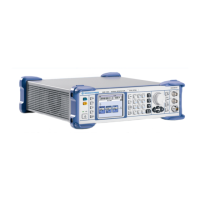Remote Control Basics
R&S
®
SMB100A
206Operating Manual 1407.0806.32 ─ 13
Note that HiSLIP data is sent to the device using the "fire and forget" method with imme-
diate return, as opposed to VXI-11, where each operation is blocked until a VXI-11 device
handshake returns. Thus, a successful return of a VISA operation such as viWrite()
does not guarantee that the instrument has finished or started the requested command,
but is delivered to the TCP/IP buffers.
For more information see also the application note at: http://www.rohde-schwarz.com/
appnote/1MA208.
6.1.3.2 VXI-11 Protocol
The VXI-11 standard is based on the ONC RPC (Open Network Computing Remote
Procedure Call) protocol which in turn relies on TCP/IP as the network/transport layer.
The TCP/IP network protocol and the associated network services are preconfigured.
TCP/IP ensures connection-oriented communication, where the order of the exchanged
messages is adhered to and interrupted links are identified. With this protocol, messages
cannot be lost.
6.1.3.3 Socket Communication
An alternative way for remote control of the software is to establish a simple network
communication using sockets. The socket communication, also referred to as "Raw
Ethernet communication", does not necessarily require a VISA installation on the remote
controller side. It is available by default on all operating systems.
The simplest way to establish socket communication is to use the built-in telnet program.
The telnet program is part of every operating system and supports a communication with
the software on a command-by-command basis. For more convenience and to enable
automation by means of programs, user-defined sockets can be programmed.
Socket connections are established on a specially defined port. The socket address is a
combination of the IP address or the host name of the instrument and the number of the
port configured for remote-control. All R&S Signal Generator use port number 5025 for
this purpose. The port is configured for communication on a command-to-command basis
and for remote control from a program.
6.1.3.4 LAN Interface Messages
In the LAN connection, the interface messages are called low–level control messages.
These messages can be used to emulate interface messages of the GPIB bus.
Command Long term Effect on the instrument
&ABO Abort Aborts processing of the commands just received.
&DCL Device Clear Aborts processing of the commands just received and sets
the command processing software to a defined initial state.
Does not change the instrument setting.
>L Go to Local Transition to the "local" state (manual control).
Remote Control Interfaces and Protocols

